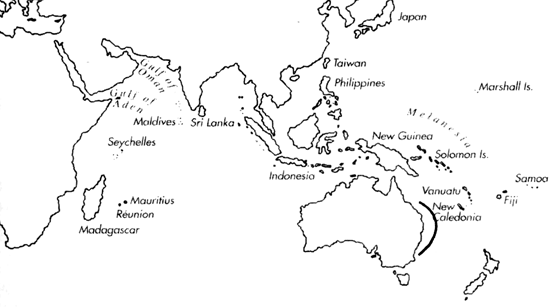Range: New South Wales to S. Queensland, Australia.
Description: Moderately small to medium-sized, moderately light to moderately solid. Last whorl conical to ventricosely conical; outline convex at adapical fifth to half, straight below; left side variably concave at basal third. Basal part of columella with a tooth-like fold. Shoulder angulate. Spire usually low, outline concave to straight, with a projecting larval shell. Larval shell of 1.75-2 whorls, maximum diameter 1.1-1.3 mm. First 1-3 postnuclear whorls weakly tuberculate to almost smooth. Teleoconch sutural ramps flat, with 2-3 increasing to 7-9 spiral grooves. Last whorl with a few weak to obsolete spiral ribs and ribbons near base.
| Shell Morphometry | ||
|---|---|---|
| L | 25-50 mm | |
| RW | 0.07-0.15 g/mm | |
| (L 25-40 mm) | ||
| RD | 0.64-0.68 | |
| PMD | 0.81-0.89 | |
| RSH | 0.05-0.13 | |
Ground colour pale bluish violet or pale pink. Last whorl with partially reticulated brown to orange-brown flecks, blotches and lines fusing into an interrupted spiral band on each side of centre. Spiral rows of similarly coloured dots variably arranged between base and shoulder. Larval whorls white to light brown or light violet. Postnuclear sutural ramps with orange-brown to brown radial markings. Aperture light violet.
Habitat and Habits: In 100-200 m.
Discussion: C. wallangra resembles C. klemae, but the latter species is usually larger and differs in its higher and stepped spire (RSH 0.12-0.21), narrower larval shell (about 0.8 mm), and in the absence of a tooth-like fold from the basal part of its columella. C. angasi has a colour pattern that is not reticulated and comprises 3 rather than 2 spiral bands; the spiral rows on its last whorl consist of dots, dashes, spots and bars, and its aperture is white, suffused with cream and pink.

C. wallangra range map
This section contains verbatim reproductions of the accounts of 316 species of Conus from the Indo-Pacific region, from Manual of the Living Conidae, by Röckel, Korn and Kohn (1995). They are reproduced with the kind permission of the present publisher, Conchbooks.
All plates and figures referred to in the text are also in Röckel, Korn & Kohn, 1995. Manual of the Living Conidae Vol. 1: Indo-Pacific Region.
The range maps have been modified so that each species account has it own map, rather than one map that showed the ranges of several species in the original work. This was necessary because each species account is on a separate page on the website and not confined to the order of accounts in the book.